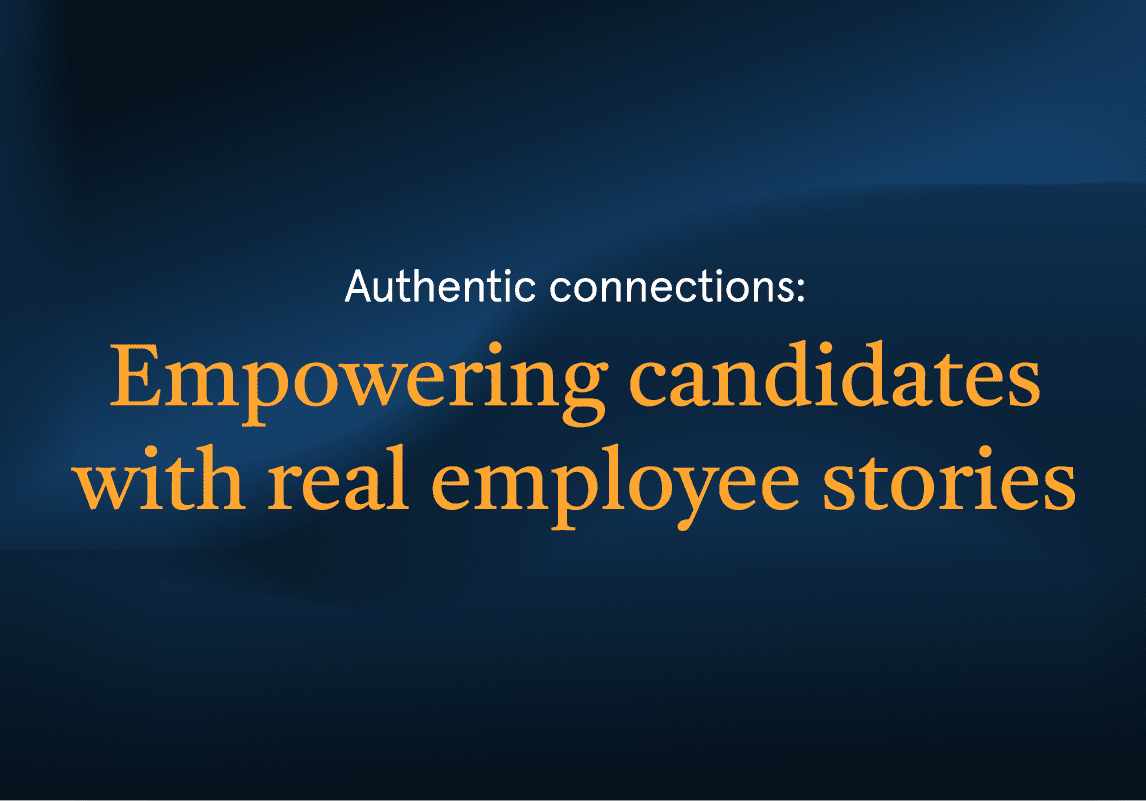Creating a proactive employer brand strategy can be tricky for many companies. We know that while 80% of talent leaders believe that employer branding is a key driver for making quality hires, only 50% believe that their employer brand strategy is where it needs to be. So, where’s the gap?
When it comes to employer branding, many companies overlook a crucial resource: your existing workforce. Showcasing your current employees and sharing their stories proves that you ‘walk the walk’ —it establishes credibility, which is key to engaging today’s discerning jobseekers.
Let’s unpack employer branding in more detail: what it is, why it’s important, and how you can use your employee stories to boost the value and authenticity of your employer brand.
What is employer brand?
Employer brand is the way that employers differentiate themselves —how they stand out from the crowd to attract the best talent. In a competitive talent market, strong employer branding is critical to attract, engage and retain top performers. It’s about showing jobseekers why they should choose to work for your company.
Why companies struggle with employer branding
To create a stand-out employer brand, you need to do more than list your corporate values on your career site: you need to prove that your company actually delivers on its promises when it comes to things like culture, inclusivity and employee benefits. But it appears that many businesses struggle to find ways to communicate this effectively.
The natural place for jobseekers to discover more about your employer brand is your career site, but typical career site content is often disconnected from the real employee experience. Instead of focusing your career site messaging on perks like ping-pong and pizza parties, a good employer brand highlights the real employee experience, not a polished corporate presentation.
Consider it from a jobseeker’s perspective: what are they looking for in a workplace? Our research shows that candidates are much more interested in what it’s like working day-to-day in a specific role, or what the hiring process is like, than in the history of your company. Many career sites fail to give jobseekers the information they’re looking for: 57% of candidates reported that companies didn’t share content like key day-in-the-life information on their career site. We call this the ‘content gap’.
Sticking purely to corporate messaging on your career site and failing to give jobseekers the information they really want in a convincing and authentic way can damage your employer brand and stop the very best talent from applying for your roles — they’re simply not convinced that you are the right employer for them.
How to use employee-generated content to boost your employer branding strategy
Employee-generated content will drive more jobseekers to hit ‘apply —and help to close this ‘content gap’. When candidates hear authentic experiences from employees, it not only gives your employer brand credibility, but also helps answer targeted jobseeker questions. Just as a product review from a fellow consumer is much more convincing than branded messaging, hearing from real employees about their experiences resonates more with jobseekers.
Research has shown that:
- 95% of candidates thought that employee-generated content, namely employee stories, was highly relevant
- 77% of candidates reported that their impression of the company improved after reading employee stories
- 98% of candidates indicated that they planned to apply to the company after interacting with employees during a live chat event
What kind of employee-generated content should you use?
A great form of employee-generated content is employee stories. Stories are persuasive: they are better remembered, they harness emotions, and they encourage readers to take action. To improve the chances of widening your talent pool and becoming an employer of choice, many leading brands encourage employees to share their own stories and experiences.
This is particularly impactful to engage diverse talent. For example, female jobseekers may want to know whether you have any internal networks for women or working arrangements that can support their family obligations. Minority applicants may face substantial barriers to entry — so showing that your hiring practices are inclusive could help encourage diverse applicants to apply. It’s about showing rather than telling: if employees with similar backgrounds or circumstances share their experiences, it’s more convincing than a corporate policy document. It shows that your company is genuine in its commitments and isn’t just looking to tick a box.
Both Millennials and Generation Z value diversity in the workforce, and these groups now make up the majority of the talent pool. To attract and engage today’s talent, it’s crucial to address diversity and inclusion on your career site —authentically.
Employee stories can educate, entertain, convince, and inspire — all in just a few minutes. Instead of a one-size-fits-all, generic approach to careers page content, creating a bank of targeted and bespoke employee stories gives your company a way to answer candidate questions and boost your employer brand in real-time.
Want to learn more about how to use employee stories to boost your employer brand?
Sharing employee stories on social media
70% of jobseekers use social media when searching for jobs to gain insights into company culture, so sharing employee-generated content on your companies social pages and channels like Glassdoor and Yelp can have a huge impact on your employer brand.
Sharing employee stories means that your employer value proposition (EVP) is communicated to potential employees via a trusted source —their peers. Jobseekers use this content to gain a clear, credible view of life at your organization.
You can also encourage your employees to share their stories on their own social accounts, which can help amplify the reach of your employer brand and expand your audience of potential employees.
In practice: scaling your employer brand through employee advocacy
A company dialling up their dialogue efforts at scale are Electronic Arts. The popular video game publisher focuses heavily on their employer brand, social media, and employees on social. In particular, they used the hashtag #WeAreEA, to enable interested prospects to easily follow EA on their social networks and view the content that the employees and the brand disseminate.
By helping their employees to create content and talk about the company they work for, they engaged their global workforce and spread brand awareness of their work culture to their target audience of jobseekers.
Conclusion
Effective storytelling isn’t necessarily what employer branding teams believe it is. Many career sites use the same testimonial video format of employees talking about how good the company they work for are. But, these testimonials aren’t authentic —and aren’t persuasive. Allowing employees to create content, answer questions or share their own experiences lends credibility to your employer brand. These authentic stories and two-way engagement can help establish relationships with jobseekers and persuade best-fit candidates to apply for a role.
Clinch Employee Connections can help you harness the power of employee-generated content with minimal effort, and maximum results. It connects potential candidates to real employees via our AI-powered Q&A discussion platform, allowing them to ask questions and get exactly the information they need, straight from the horse’s mouth. These answers create on-brand content that can be shared on your career site or on social media.
To find out more about how Clinch can help boost your employer brand, request a demo today.



